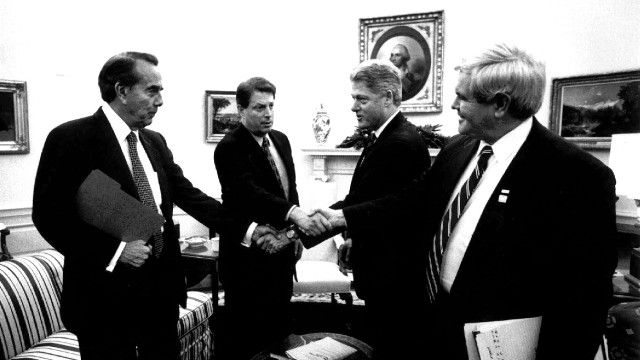
It’s become a political cliché that “red” and “blue” states represent two Americas. But consider how states prioritize programs like health care and education — or how they administer their social safety nets — and the differences are very real. Federal policies help smooth out some of those differences — everyone is eligible for the same Medicare and Social Security programs when they get older — but conservatives have long campaigned to broaden the divide by turning over more and more federally administered programs to the states.
We can see how that might play out by looking to the past. In 1996, Congress “reformed” our existing welfare system in much the same way Rep. Paul Ryan (R-WI) wants to “reform” Medicaid and other anti-poverty programs: they killed off the federal entitlement and turned the money over to the states to implement new models of welfare as they saw fit. It was a central plank in Newt Gingrich’s “Contract with America” 20 years ago and also considered one of Bill Clinton’s signature achievements.
University of Minnesota sociologist Joe Soss spent a decade studying how those reforms shook out in the real world. With Richard C. Fording and Sanford F. Schram, he co-wrote the book, Disciplining the Poor: Neoliberal Paternalism and the Persistent Power of Race, explaining how race became a determining factor in how states created their own welfare programs — and how that ultimately led to a system that’s rife with racial bias.
BillMoyers.com spoke with Soss last week. Below is a lightly edited transcript of our discussion.
Joshua Holland: Slightly fewer than one in three welfare beneficiaries are African-American. But it seems clear from the rhetoric around welfare that a lot of people think of it as a program for blacks. How did that view play into the welfare reforms of the 1990s?
Joe Soss: In the 1980s and ’90s, a kind of narrative had emerged that I call the story of illegitimate takings. It held that there were white people who played by the rules, and then there were people of color — and particularly black people — who were taking from those people in an illegitimate way.
At the time, there was a lot of talk of the pathologies of the underclass. And many believed that it was really these liberal programs that were to blame for what was seen as a kind of crisis of crime and disorder and sexual irresponsibility and welfare dependence and all of these things.
Bill Clinton ran on this idea that he was going to end welfare as we know it. And he was also going to get tougher on crime. He was attempting to reassure white voters, but once the Republicans took Congress, in 1994, Clinton found that he had painted himself into a corner, because of course the Republicans were willing to go much farther in this game than he was.
After that, for a public that had already learned to think of welfare as a black program — that had internalized these Republican calls to get tough on the welfare queens and whatnot — welfare now became center stage. The public was aroused, so something had to be done.
We looked at public opinion on welfare and racial attitudes, analyzing not just the overall trends, but studying the views of actual individuals over time. And what we found was fascinating. First, not many other factors predicted who would hold those kinds of views of welfare. It was pretty broad. But the one thing that did predict a negative view of welfare was negative beliefs about African-Americans, particularly a belief in black laziness. And also stereotypes of black women as being sexually irresponsible.
What’s remarkable about the general association of black people with welfare and handouts in the popular culture — that stereotype — is that it’s almost a perfect inversion of American history. For much of the 20th century, and certainly in the earlier history of this country, we had all sorts of race-specific programs that channeled benefits to whites and excluded everyone else.
So until very recently, in many ways we have this long history of a white-centered welfare state. But after that time, when victories were achieved that actually allowed for some equality of access to those programs, that very equality became the basis for saying, “Oh, this is all about African-Americans and it’s just a handout to this racially targeted group.” It’s a very sad part of American history, very troubling.
Holland: One of the central provisions of welfare reform was replacing the federal welfare system established during the New Deal with a block grant program which gave the states the ability to design their own programs. You wrote that state officials implemented their policies in ways that “proved remarkably sensitive to racial differences.” Can you explain that finding?
Soss: After welfare reform passed, the federal government said [to the states], “Here are a bunch of goals we want to accomplish. We want, first and foremost, for you to put people to work, and we want to discourage childbirth, and we want to promote marriage… You’re now free to figure out how to do these things.”
What happened was pretty remarkable… What you see in this crucial period of recreating the system is that pretty much the only thing we could find that really drove one policy decision after another was the percentage of minority recipients on the welfare rolls at the time.
In other words, people had become so focused on racial issues that race really drove the patterning. They were not necessarily conscious of it; it was race-coded and below the radar for most people. But all of the states with more African-Americans on the welfare rolls chose tougher rules. And when you add those different rules up, what we found was that even though the Civil Rights Act prevents the government from creating different programs for black and white recipients, when states choose according to this pattern, it ends up that large numbers of African-Americans get concentrated in the states with the toughest rules, and large numbers of white recipients get concentrated in the states with the more lenient rules.
So state freedom to make these different choices became the mechanism for recreating a racially biased system across the states, where the toughness of the rules you confronted really depended on your racial characteristics.
Holland: According to your study, just five years after the passage of the Welfare Reform Act, 63 percent of families in the least stringent programs were white and 11 percent were black, and in the most restrictive programs — that is, the ones with the toughest penalties and the most stringent requirements for eligibility – 63 percent were black and just 29 percent were white.
Soss: Yes, and the stringency of the rules matter tremendously for outcomes. The tougher the rules — and the more frequently people are punished for breaking them — the worse the outcomes are for people after they finish the program.
In fact, in the toughest programs, people actually end up in worse shape after they get through them than they were before they got the benefits to begin with. And remember, they were in such a bad situation that they had to turn to a welfare program that’s been so stigmatized that pretty much everyone wants to avoid it.
We also found that people who go through the toughest programs learn lessons about government that lead them to retreat from participating in politics. They become less likely to make their voices heard, and less likely to participate in elections and community organizations.
Holland: About 40 percent of the African-American population live in the Deep South, where there are also very conservative state governments. Is it possible to untangle racial animus from ideology when it comes to designing these programs?
Soss: In one sense the question you’re asking is whether this is all just about how the South is different. And the answer is no. But ideology matters.
Here’s an interesting finding: In our study, we found that, not surprisingly, conservative counties and areas tended to sanction welfare clients much more often — they were much tougher on beneficiaries — than the most liberal counties. But what we found was that almost the entire difference was made up by the different treatment of black and Hispanic clients. For white clients, it actually made no difference whether you were in the most liberal or most conservative county. You’d be treated the same regardless. It was only clients of color who received different treatment in conservative and liberal counties.
Holland: One of the experiments you did was at the level of the program administrator. You used imaginary, “blind” cases to test for administrators’ attitudes towards their clients of different ethnicities.
Soss: We used identical, made-up case files. The only differences between them were that some had what are considered “black names,” and others had “white names.” So one would be like, Emily O’Brien and on another we put Lakisha Williams. We pretested them to show that most people who saw these names, right or wrongly, associated them with white or black people — or Latinos.
And we then presented actual welfare case managers with cases where it wasn’t quite clear whether the person should be sanctioned or not. Again, it was the exact same case, except we varied the name, and therefore, the race they associated with the person.
And then we also varied one other thing, which you can call a discrediting marker. So in one of the experiments, we looked at what happens if you add information that the imaginary beneficiary had been sanctioned before — maybe that would lead the case worker to think they’re a troublemaker. That should have no bearing on the current sanction decision, but it might just change their view. Or we changed the number of children they had — for half of the case managers, the person had one child; for the other half, they had four children and were pregnant.
And we found that, across all of our experiments, for the white client, adding that marker — which invoked a negative image of welfare recipients — had no effect at all. They were still judged the same way on the current matter.
The black client or the Hispanic client, when they did not have this discrediting marker, were also judged neutrally on the borderline problem we gave these managers. So there wasn’t an automatic bias. But when you added that discrediting marker, the likelihood that the person would get sanctioned went through the roof if they were a person of color. In other words, the person might not be discriminated against if there was nothing there that provided a kind of cue, but as soon as you added something that seemed to confirm the negative stereotypes about welfare recipients, it had no effect on the white client, but it made the black client seem like a person who should be sanctioned, and the rates went up.
And the thing that’s really fascinating is that this was equally true for all case managers, regardless of how they self-identified in terms of race and ethnicity. It was equally true of white case managers and case managers of color.


